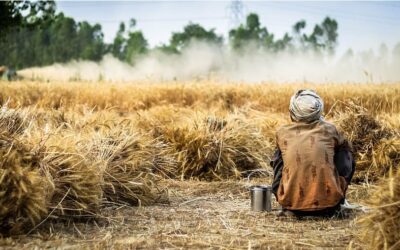Digital finance – including smallholder farmers in the equation

Telecommunication technologies have advanced and spread more rapidly than I could ever have imagined. In the 80s we were using walkie-talkies to communicate in the field. Today every sphere of commerce has been enriched by an app or two that is “disrupting” (as those in the tech industry say) the status quo. This, however, is true only of the world’s more urban sectors. Rural areas, where the majority of the world’s food is sourced, and where most of the African population lives and works, have been waiting patiently for the telecommunications era to reach them. And this means more than having access to social media in rural areas.
Digital tools have the ability to strengthen agricultural transformation – enabling agriculture to be an innovative and sustainable enterprise that creates value for farmers, entrepreneurs, youth, and women, and produces affordable, and high quality food for all. As I have written about before, it is clear to me that D4Ag (digitisation for agriculture) is taking centre stage in the discussions on how to transform Africa’s agriculture into the powerhouse it has the potential to be.
Embedded in these conversations is the aspect of financial inclusion and how digital tools can contribute. In the last few years, we have seen a rapid transformation in data analytics and payment technologies, financial services business models, and resulting financial products for smallholder farmers. This shows that even though the financial ecosystem is multilayered and highly specialised, services are evolving to match it.
However, smallholder farmers in Africa continue to face severe financial challenges. For these farmers, the objective of improved access to digital financial solutions would be to provide tailored and affordable products and services that open up new opportunities. As things stand at present, financial service providers (FSPs) are still concentrated in urban areas, specialising in non-agricultural sectors. Urban residents have four times the access to a financial institution than a person living in a village, as it is not always cost-effective for banks to build branches that cover these rural areas. In 2017, there were approximately 5.3 commercial bank branches for every 100,000 adults in SSA, as compared to 21.5 in OECD countries. Lending and insurance rates for agribusinesses are also high, as FSPs take the volatility of the climate into account. This means that those involved in agriculture, especially the smallholder farmers, are in a highly precarious market with few safeguards.
Recently, EFF contributed to an action report that was compiled by the Dutch Sustainable Trade Initiative (IDH), the Consultative Group to Assist the Poor (CGAP), and the Office of the UN Secretary-General’s Special Advocate for Inclusive Finance for Development (UNSGSA), H.M. Queen Máxima of the Netherlands, with input from the UNSGSA’s Agriculture Finance Working Group. The report, titled Sowing the Seeds of Innovation for Smallholder Finance introduces the issues hindering effective rural and agricultural financial systems by dividing them into two large problem areas:
- Sparsely populated rural areas need innovative financial services that can meet the needs of smallholders and agri-SMEs
- Financial service providers’ existing business models make serving this market inviable
Financial institutions are often not well-equipped with the information needed to provide financial services to people in farming; they do not always have the full picture of farmers’ financial needs, their risk profiles, or the market conditions, which makes them hesitant to approve loans. This has created a global finance gap in agriculture of US $170 billion. To add to this, the report defines existing business models within the finance industry that are unable to effectively address rural needs.
Very often, the vacuum left by the financial sector is filled by those distributing seeds, or fertilisers, or those buying and trading in agricultural products. These are members of the agricultural value chain who have the most capital, a deep understanding of farmers’ needs, are in proximity to them, and know the feasibility of agricultural investments. These actors, who offer mostly short-term credit, can sometimes be the biggest agricultural lenders in the country.
However, since they are not primarily financial institutions, they do not have the tools and resources to fully service the needs of their clients. They cannot provide farmers with savings, insurance, or long-term credit options. We can see the need for a partnership to reach rural clients, where financial groups need knowledge that agribusinesses have, and agribusinesses need the capital that financial institutions can provide.
An example of creative relationships was seen between the Mastercard Foundation and Kenya Commercial Bank (KCB). Together, the two institutions launched MobiGrow, a service to promote financial inclusion among smallholder farmers in Kenya and Rwanda. Using a proprietary credit-scoring algorithm, the MobiGrow was able to provide farmers with loans for periods of 3 to 6 months. This partnership between an NGO and a commercial bank towards building a digital service shows that out-of-the-box thinking could assist in bridging the finance gap for farmers.
Sowing the Seeds stresses the importance of these kinds of partnerships – not just between non-profits and financial institutions, but also with governing bodies. Among the prerequisites for fintechs to be inclusive are digital and financial literacy, connectivity, and cybersecurity. These are opportunities for public sector players to step in and strengthen the foundation for the ongoing agricultural revolution. Cross-industry partnerships are not inherently risky, but they can be intensive in the data and capital they require. When setting up, organisations have to consider costs of research, human resources, and others, and deliberate on the rules of their partnership.
“All of these assessments need to be done without guarantee that the partnership will work and be profitable for all actors involved.”
- Sowing the Seeds of Innovation for Smallholder Finance
If partnerships are created with this basic tenet as a guiding principle, that places value on something bigger than profits, I am confident we will be able to propagate effective financial inclusion models that have the interests of smallholder farmers in their DNA, and which can then be scaled-up, replicated, and ultimately become profitable for all the actors involved.
Continue Reading
World Environment Day – Revisiting “Only One Earth”
Climate change is real. It affects developing nations disproportionately as compared to developed nations. Developing nations should not wait for help to do good for the environment but work towards ensuring that these challenges are met headlong. They should know that sustainability goals and development is not mutually exclusive.
World Food Crisis – How Africa can be the long-term solution
Africa has abundant resources to be the food factory for the world. This holds true especially for vegetable oil crops such as Sunflower, palm, soybean and rapeseed. Tanzania provides ideal conditions for growing sunflower at scale and supply it’s oil to the major consuming nations such as India.
Earth Day – Rising to the challenge of saving ourselves
We need to find solutions to ensure we can not just stop but reverse climate change. One solution is regenerative agriculture that can not only improve the yields for the farmers, but also reduce their carbon footprint.




0 Comments